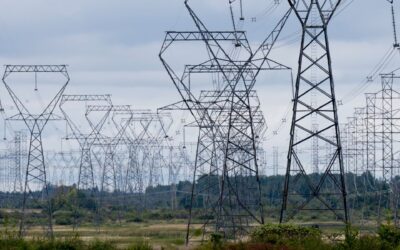Originally published in Policy Options
Electricity is the shining light of Canadian climate policy. While overall greenhouse gas emissions in Canada have risen since 1990, emissions from the electricity sector have fallen by more than one-third — even as the population and economy have grown. A mix of regulations (e.g., Ontario’s coal phaseout) and more stringent carbon pricing are behind this trend.
The federal government wants to go further by setting a goal of net-zero emissions in the sector by 2035. But how can it deliver on this target when the provinces face very different challenges and electricity is provincially regulated?
One option that has been discussed recently is a “clean electricity standard,” a regulation on allowable emissions from electricity generators across the country. This is squarely in federal jurisdiction under the Canadian Environmental Protection Act of 1999, as is the second option, carbon pricing, per the Supreme Court decision in 2021. Together, these two policy levers would give the federal government the tools it needs to deliver on net-zero electricity.
So, how should the federal government use these two options to achieve net-zero emissions in the power sector by 2035? We argue it should do so by strengthening its approach to carbon pricing in the electricity sector, and by putting a clean electricity standard in a supporting role. We unpack each policy in turn.
Strengthen carbon pricing
Perhaps nowhere is the effect of carbon pricing as clear as in the power sector. By raising the marginal cost of carbon-emitting power generation, the mix of generation is shifted toward lower carbon options. Evidence from the U.K. shows its carbon-price floor (specific to the electricity sector and on top of the EU-wide carbon-pricing scheme) was instrumental to the country’s rapid move away from coal power. In Alberta, too, the provincial carbon-pricing scheme implemented in 2018 led to a marked decline in coal-fired generation. By 2023, the province expects all coal-fired generation to be gone, well ahead of the 2030 coal phaseout deadline.
Yet, Alberta’s example illustrates one of the deficiencies of the current suite of policies in terms of a net-zero future: much of the coal-fired generation is being replaced by generation from natural gas. This leads to lower emissions, to be sure, but it’s still a far cry from the goal of net-zero.
The question is: Can carbon pricing go even further? Is it capable of achieving the federal goal of net-zero emissions by 2035?
A first critical step would be to strengthen the way the federal carbon price is applied in the electricity sector. Under the federal policy, electricity generators in Canada fall under a carbon-pricing scheme called the output-based pricing system (OBPS). The specific way that the federal OBPS is currently applied in electricity has design issues that undermine its effectiveness. It’s also not clear why the sector needs the OBPS treatment in the first place, because electricity does not meet the standard of being an emissions-intensive and trade-exposed sector that warrants OBPS treatment, unlike sectors such as steel or cement. Granted, the current approach helps reduce electricity price impacts, but it also reduces the effectiveness of the policy.
By doing away with OBPS for the electricity sector altogether, the federal government could considerably strengthen the effectiveness of its carbon-pricing policy. Removing the current OBPS treatment would ensure the emissions differences of the various types of power generation were properly reflected, and it would remove the distortions created by current policy.
To avoid consumer price impacts and large interprovincial transfers, all the revenue collected could simply remain in-province (as is the current approach under the federal carbon levy) and be returned directly to electricity consumers on their bills. The result of these changes would be that while the price of power would rise, the ultimate cost to end users would be offset by the consumer rebate. This follows the model of California, where power generators face a carbon price, but distribution utilities return the carbon revenues to consumers.
The net effect of doing away with the OBPS in electricity and returning carbon-price revenues from the electricity sector to provincial ratepayers would be 1) increased incentive to reduce emissions from power generation, and 2) protection of consumers and businesses from significant increases in electricity prices.
Because the federal policy would act as the benchmark for assessing whether provincial policies were equivalent, this change would ensure that provincial policies were (or became) equally strong. As long as electricity regulators were directed to not consider the effects of the rebate when weighing utility investment decisions, there would be no concern about the rebates undermining the overall imperative to reduce emissions.
But even with these changes an additional step may be required. Alberta’s provincial carbon-pricing policy for electricity, for example, avoids the shortcomings of the federal approach. Yet, in that province, new natural gas-fired capacity is being built (i.e., beyond coal-to-gas retrofits) that is unlikely to remain competitive as climate policy stringency tightens in line with stated federal targets.
This raises the question: Why would any generation company or provincial utility be considering building a generating facility using natural gas right now? A significant part of the answer is because of uncertainty over future carbon policy. Case in point: while the federal government has declared that prices will rise to $170 per tonne by 2030, the government of Alberta only recently set out its carbon-price path to 2022; its price path beyond this year remains uncertain. Even if a $170-by-2030 carbon price was the active policy across the land, investors and utilities might still be uncertain as to the political durability of that policy. After all, it was only a few months ago that an election was held that, with a different outcome, would likely have changed the outlook for future federal carbon prices.
Reducing policy uncertainty would help drive investment decisions that are more in line with stated policy and emissions targets. One key way the government could do this is through financial instruments, for example via the Canada Infrastructure Bank (CIB), that guarantee future carbon prices. Effectively, the CIB would take on the risk of 2030 carbon prices being below $170. Investors could then be assured that they would not be affected by potential future policy reversals. Policy certainty would improve even for those who didn’t secure these kinds of contracts, because once others did, they would see that any future government had a credible reason to maintain its policy path (i.e., to avoid the financial losses associated with reversing course).
In short, using financial instruments could smartly place the policy risk where it is best held, with government, leaving firms to invest according to “fixed” future carbon prices – strengthening carbon pricing simply by making its future path more certain.
Implement a performance-standard regulation
While more stringent carbon pricing, coupled with more certainty on future prices, could do most of the heavy lifting in eliminating emissions from the electricity sector, it couldn’t guarantee that the 2035 net-zero target will be met.
A performance-standard regulation for the electricity sector (such as the proposed but still undefined clean electricity standard) could backstop a strengthened carbon price by ensuring the 2035 target for net-zero electricity production is reached. It could also help to resolve policy uncertainty, to the extent that firms believe regulations are less likely to be repealed than carbon pricing.
The performance standard could be applied in two tranches.
First, the clean electricity standard could set a limit on the emission intensity of all newly constructed generation facilities. The level could be set lower than that of unabated natural gas (to rule out construction of new gas capacity) but leave room for near–zero technology, such as carbon capture or certain forms of hydrogen. Setting the limit this way would avoid letting the costs of new natural gas assets fall on ratepayers (or taxpayers) in the event that those assets were later stranded.
Second, the clean electricity standard could ratchet down such that by 2035 all new and existing facilities would need to be net-zero. Regulated facilities could comply in part (if they chose) by procuring negative emissions, and the allowable types of emissions offsets, as well as procurement and validation protocols would be clearly laid out in the regulation. This compliance flexibility is critical to avoid large electricity price spikes or reliability problems in the event that non-emitting sources of dispatchable, or “on-demand” generation and other types of flexibility that can help manage the variability of renewables are not sufficiently advanced by 2035 to cost-effectively displace the relatively small amount of gas-fired generation that might remain economically viable under a high carbon price. It would allow electricity systems to use some fossil generation — sparingly, with volume limits to keep emissions in check, and fully offset — when other options are scarce.
This kind of simple performance standard for the emission intensity of power plants operating in Canada could serve as the model for the clean electricity standard promised by the federal government. It would provide a backstop to a strengthened carbon price by ensuring delivery of net-zero electricity by 2035, while still letting market incentives from carbon pricing play the primary role in driving cost-effective emissions reductions. By providing a measure of flexibility, it would ensure that the 2035 target could be met in a way that would not impact electricity system reliability.
Making smart use of available tools
The federal government has already put carbon pricing at the centre of its greenhouse gas emission-reduction strategy. So, rather than building an elaborate clean electricity standard that would duplicate much of what a strengthened carbon price could do, the federal government should strengthen its existing approach to carbon pricing in the sector. An optimal clean electricity standard, for its part, will be one that complements carbon pricing, rather than substitutes for it.
Of course, these are not the only roles for the federal government in electricity. Enabling better integration between provinces through co-ordination and expanded transmission is another. Stay tuned for a deeper dive on using federal and provincial policy to align electricity systems with net-zero in a forthcoming report by the Canadian Climate Institute.








